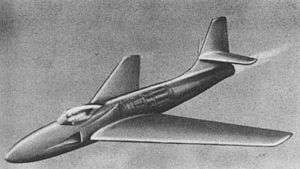NACA duct


A NACA duct,[1] also sometimes called a NACA scoop or NACA inlet, is a common form of low-drag air inlet design, originally developed by the U.S. National Advisory Committee for Aeronautics (NACA), the precursor to NASA, in 1945.
When properly implemented, a NACA duct allows air to flow into an internal duct, often for cooling purposes, with a minimal disturbance to the flow. The design was originally called a "submerged inlet", since it consists of a shallow ramp with curved walls recessed into the exposed surface of a streamlined body, such as an aircraft. It is especially favored in racing car design.
Prior submerged inlet experiments showed poor pressure recovery due to the slow-moving boundary layer entering the inlet. This design is believed to work because the combination of the gentle ramp angle and the curvature profile of the walls creates counter-rotating vortices which deflect the boundary layer away from the inlet and draws in the faster moving air, while avoiding the form drag and flow separation that can occur with protruding scoop designs. This type of flush inlet generally cannot achieve the larger ram pressures and flow volumes of an external design, and so is rarely used for the jet engine intake application for which it was originally designed, such as the North American YF-93 and Short SB.4 Sherpa. It is, however, common for piston engine and ventilation intakes.
See also
References
- ↑ Frick, Charles W., et al. NACA ACR No. 5120, An Experimental Investigation of NACA Submerged- Duct Entrances. NACA, November 13, 1945. Abstract, Full report.
Further reading
- Staniforth. Race and Rally Car Sourcebook. ISBN 1-85960-846-9. (Practical guidance on designing and building NACA ducts for motor-racing applications)
External links
| Wikimedia Commons has media related to NACA ducts. |
- Abstract of NACA ACR 5I20 report and .pdf file
- Archive of NACA reports 1917-1958
- Warren Beauchamp (2000). "NACA Duct Rationale and Construction".
Practical experience of fabricating simple NACA ducts for ventilation of a HPV